
By Coach Erik Schjolberg – Jan 8, 2024
Contents
Key Takeaways
- The Ping G425 has three unique options (Max, LST, and SFT)
- Max = fairway finder; LST = low spin; SFT = slice killer
- Clean matte design for sleek glare-free look
- Turbulator Ridges improve aerodynamics and alignment
- Moveable tungsten weight for fine tuning ball flight
The modern age driver is the equivalent of the “big gun” that gets pulled out at pivotal points of a movie; the hero is standing there, poised, pulls out his weapon of choice and BOOM wins the day with a big bang.
If Callaway and Taylormade are the heroes standing there behind the big loud explosions, Ping is the silent assassin, an unsung hero, a ninja in the night.
The driver is effective, subtle, sexy, and will help you find the fairway in an understated package. Welcome the new G425 line, with a model for everyone, and arguably Ping’s best driver yet.
Ping G425 Driver Review (The SERIES as a whole)
>> Click here to jump to Ping G425 MAX driver review <<
Driver Models – Ping G425 Max vs LST vs SFT
- The Max
- LST (Low Spin Tech)
- SFT (Straight Flight Tech)
Ping G425 MAX Driver Review





Lofts Available: 9º, 10.5º, and 12º
Shaft Options: Yes
Pros:
- Very stable feel on impact
- Clean looks with a matte finish
- Did I mention tungsten? (Lots of it!)
- Tons of forgiveness on off-center hits
- Ease of use for beginners and scratch golfers alike
- Ample tungsten weighting to help get the ball in the air
- Similar price point compared to 2021-2022 competitors
Cons:
- “Exotic” shaft options are an upcharge
- Low launch/spin shaft options are limited
- Turbulators are polarizing (some love them, some hate them)
- The driver is louder than its siblings, but not the loudest I’ve hit
The Max driver logically replaces the “Plus” from the G410 series, while the LST and SFT carry through.
Confident drivers with higher swing speeds will typically gravitate towards the G425 LST model in their quest for piercing trajectory and spin reduction for optimal carry and rollout, while those newer to the game, or seeking to correct a slice will stray towards the G425 SFT with its designed fixed weight and draw bias.
Players both high and low handicap will enjoy the benefits and forgiveness of the Max model with its ease of use and fairway finding tendencies.
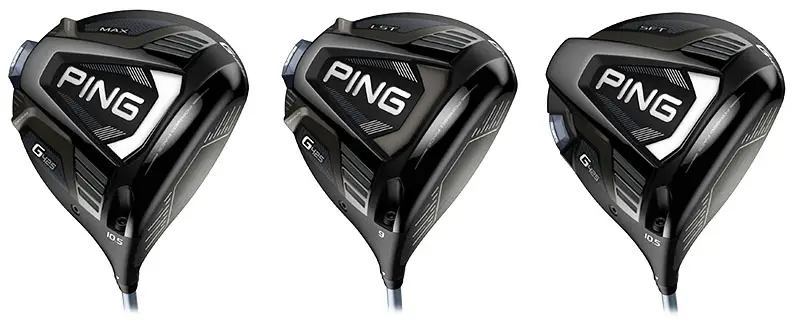

Looks


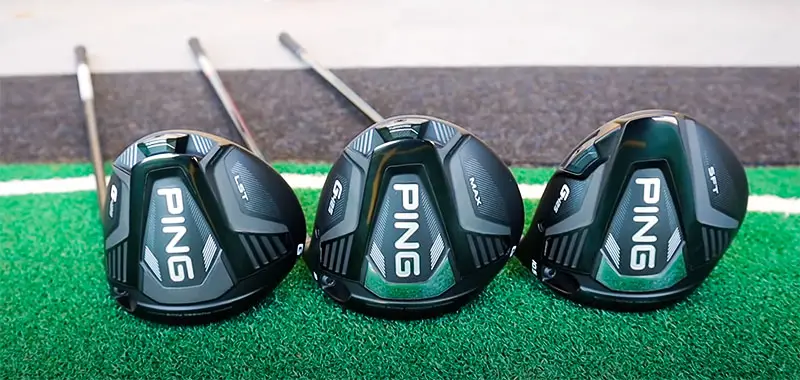

One thing Ping has done phenomenally well over the years is producing a clean, matte crown for players who prefer less flashy clubs that don’t blind you with glare on a sunny day at the links.
They have perfected the G-line of products to look sleek without distracting colors or flash, while still inspiring confidence that you’ll hit the fairway. At address, Ping continues to trick the eye into seeing a more compact aggressive head, especially during your pre-shot prep lining up the ball with your target.


Granted, the turbulator ridges on the crown are not for everyone, but I find that they help frame the ball nicely whether you’re aiming to play a draw or fade… or knock one straight.
All three G 425 models present a clean cut, rounded shape from any angle, and take the cake when it comes to subtle yet confidence inspiring lines that flow to the back of the head.
Construction and Tech
This 2021 Ping update takes a slightly different approach to moment of inertia (MOI) and center of gravity (CG) than they did last year for a boost in forgiveness.
Those of you who are fans of the G410+ will recall the long, slim track at the back of the driver that allowed you to tune your ball flight path aggressively with a 16g weight. Ping honed this track design for optimal ball speed, and better return on investment when the ball falls out of the ideal strike zone in the Max, and tailored modifications to the formula for the SFT and LST.
In each of the updates, you’ll find a boost in the moveable tungsten weights ranging from 17g to 26g. Simply put, unless you’re looking to reduce backspin, the more tungsten available low in the head, the more stable the driver face will be on impact.


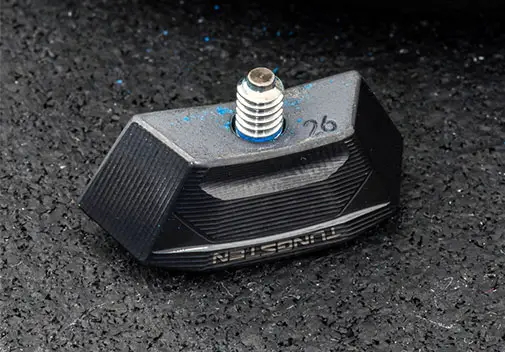

Internal Dragonfly technology returns this year with hints of tail lines flowing from the turbulators on the ultralight titanium 8-1-1 alloy crown. While not aesthetically pleasing for everyone, the turbulators remind me of the angles on a sportbike with hints of “fast” and “controlled” at address.


Along with the Dragonfly webbing in the crown, Ping improved the support structures of the head-body to help preserve solid feel and sound.
The Precision Forged Face also remains staple, with an elongated etched “V” to deliver fast ball speed and overall distance, while acoustics carry the same low-pitched “thwock” signature to Ping.


In the spirit of tuning, Ping continues to couple the weight system with a Trajectory Tuning 2.0 shaft tip, allowing eight different adjustments ranging from +/- 1.5º of loft, and 3º of lie adjustment.


As always, Ping offers a wide variety of shaft options that will appeal to new players and scratch golfers alike, all equipped with built in Arccos Caddie Smart Grips.




Standard playing lengths are a bit longer than traditional at 45 ¾” stock shafts from Ping with notable exceptions in the Ping Tour 65 and 75 shafts (playing at 45 ¼”).
Worth the Upgrade? – Ping G410 vs G425
The Ping G410 vs G425 driver – For those of you debating whether to revive your old driver with the latest G 425 equivalent, or whether it’s worth the approximately $100 savings of last year’s model, consider the design priorities of this edition.
CG (center of gravity) and MOI (moment of inertia) are a top priority to tune your strikes for the best performance, and to minimize distance loss when you’re not swinging like the Norwegian sensation Viktor Hovland.


With up to 26g of tungsten in the Ping G425 vs G410 edition, there is more weight low and behind the ball to launch hot and high while preventing any deflection of the face on off-center hits.
Simply put, it’s a fairway finding recipe, a silent assassin to shave off strokes from the tee.
(Check out all the Ping Drivers by Year and when each was released here)





Lofts Available: 9º, 10.5º, and 12º
Shaft Options: Yes
Pros:
- Very stable feel on impact
- Clean looks with a matte finish
- Did I mention tungsten? (Lots of it!)
- Tons of forgiveness on off-center hits
- Ease of use for beginners and scratch golfers alike
- Ample tungsten weighting to help get the ball in the air
- Similar price point compared to 2021-2022 competitors
Cons:
- “Exotic” shaft options are an upcharge
- Low launch/spin shaft options are limited
- Turbulators are polarizing (some love them, some hate them)
- The driver is louder than its siblings, but not the loudest I’ve hit
Lofts Available
9º, 10.5º, and 12º – All adjustable
Check this article out if you’re thinking “what loft driver should I use?”
Handicap Range
The Max is an all-purpose driver. Players that are interested in distance will find it, with ample forgiveness as well. There’s also nothing in the design that would make it more difficult to shape your shots.
Anyone can use this driver and benefit from the technology. However, the driver is less beneficial for high swing speed players who will lose distance due to launch and backspin thanks to the extra weight and super low CG.
Technical Review
The Max model focuses most on forgiveness and getting the ball up into the air.
It’s a point-and-shoot stick that will put you in the fairway when matched with the right shaft.
As mentioned in the overall review, the G425 series optimizes this update by using large quantities of tungsten to shift weight around, coupled with an overall reduction in weight for the crown.
Specifically in the Max, you’ll find a boost to a 26-gram tungsten weight with three more centralized positions. The Max represents the largest head in the series with a total volume of 460cc, up 5cc from the 455cc of the previous G410+.


Ping even managed to shave 10g throughout the rest of the head to keep the static weight around 206g allowing you to whip the head through contact.
Ping G425 Max Driver Shaft Options
Ping offers a complement of shafts for no additional charge including the branded Ping Alta CB 55 slate, Alta Distanza, and the Ping Tour; Aldila Rogue White 130; and the Mitsubishi Tensei AV Orange to accommodate all desired launch parameters from low to high.


Swing weight through each of the lofts is a standard D3 while the lie angle sits at 58.5º.
(More on what driver shaft length is right for me)
Performance – My Test Results
The focus on this edition of the Max head is MAX-imum forgiveness.
- Consistent ball-speed production throughout the face
- Finding the fairway with tighter dispersion.
The Max certainly accomplishes both. While Ping may not win any general awards in pure ball speed and distance, the G425 Max is nothing but consistent.
In my testing with its siblings, the Max tended to produce the tightest lateral dispersion, allowing me to find the fairway in a similar position most often.


Toe and heel strikes are less noticeable from a feedback perspective than with the SFT and LST, and are less pronounced when looking at ball flights.
Naturally, a proper slice or hook will pull off the fairway regardless, but ball strikes within the range of the centermost turbulators were perfectly playable.
Reasonable off-center strikes with similar swingspeed still produced respectable drives with a loss of around 10-15 yards.
Looks
When you look at most Max drivers, you immediately think “chunky and obnoxious”, “this thing is going to be loud”.
While I don’t suggest you go through a bucket of balls in a closed-off stall without at least a pair of headphones, the Max defies the “large” looking stereotype with crafty use of the matte color scheme and a rounder shape.


The overall size and weight of the driver remain almost the same as the G410+ despite growing an extra 5cc. Traditionalists that are accustomed to smaller head shapes will not be offended by the Max despite its big-ball reputation and will likely notice little difference throughout each of the models.
The very same (sensitive) traditionalists will likely gripe at the continued use of the turbulators on the crown of the club, but they appear confidence inspiring overall for me, as they frame the ball at address.
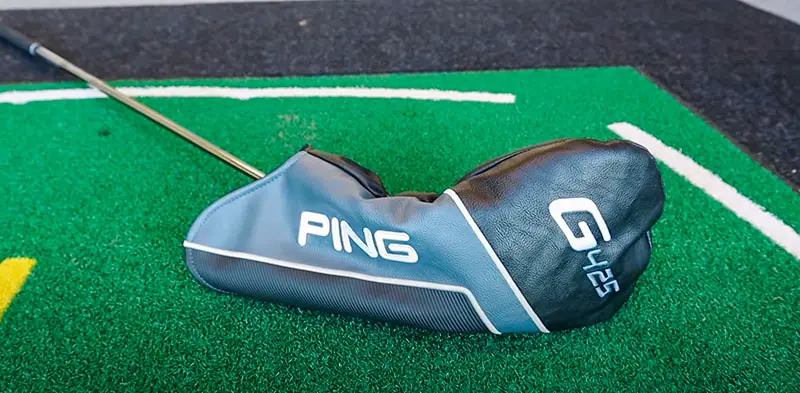

Absolutely no one should complain about the deep shades of black and gray that give this driver a sense of sophistication and seriousness amidst a world of color and customization.
Sound and Feel
Alas, there had to be something! The Max driver unfortunately is the least acoustically favorable driver among its siblings with a higher pitched strike than the SFT or LST.
While the sound is not offensive and retains the traditional Ping “thwock”, it is LOUD.
Jokes aside, you will draw looks at the range if you have a closed off environment and work through a long practice session. Outdoors there’s no difficulty and every drive sounds like you’ve crushed it. Cheers!


Feel is consistent with the prior G410+ edition, and centered strikes jump off the face feeling powerful.
Due to the design of the dragonfly webbing throughout the crown and the T9S+ forged face (boldly advertised on the base of the head), the G425 Max rapport feels solid as opposed to metallic and bouncy like some of its competitors.
Ping spent a lot of time with this head to make the user feel comfortable swinging it and satisfied with the results.
Pros
- Tons of forgiveness on off-center hits
- Ample tungsten weighting to help get the ball in the air
- Very stable feel on impact
- Clean looks with a matte finish
- Similar price point compared to 2021-2022 competitors
- Did I mention tungsten? (Lots of it!)
- Ease of use for beginners and scratch golfers alike
Cons
- The driver is louder than its siblings, but not the loudest I’ve hit
- “Exotic” shaft options are an upcharge
- Low launch/spin shaft options are limited
- Turbulators are polarizing (some love them, some hate them)
The Bottom Line
Simply put, this driver is a fairway finder with anyone who has a modicum of confidence swinging the big stick. Truly a jack-of-all-trades that the vast majority of the population will be hard-pressed to keep out of their bag.





Lofts Available: 9º, 10.5º, and 12º
Shaft Options: Yes
Pros:
- Very stable feel on impact
- Clean looks with a matte finish
- Did I mention tungsten? (Lots of it!)
- Tons of forgiveness on off-center hits
- Ease of use for beginners and scratch golfers alike
- Ample tungsten weighting to help get the ball in the air
- Similar price point compared to 2021-2022 competitors
Cons:
- “Exotic” shaft options are an upcharge
- Low launch/spin shaft options are limited
- Turbulators are polarizing (some love them, some hate them)
- The driver is louder than its siblings, but not the loudest I’ve hit
Alternative Choices to the G425 Max
TaylorMade SIM 2 Max
If you’re a TaylorMade loyalist, the SIM 2 MAX is a similar driver in the same ‘high forgiveness’ category. It’s going to have some different pros/cons obviously, so check out our review of the SIM 2 Max Driver here if you’re interested in a detailed breakdown.
Callaway Epic Max
Or if you much prefer Callaway, their somewhat equivalent driver is the Epic Max. It’s also got several adjustable weights and such similar to Ping’s G425 Max. Read the full review of Callaway’s Epic Max if you want to know more.
Cobra Radspeed XB
Cobra’s maximum forgiveness option is the Radspeed XB, “Xtreme Back”, meaning there is extra weight in the back of the driver, resulting in extra forgiveness.
FAQ
Note – Some of these FAQs were covered throughout the article, but I still get these questions a lot… so here are the “short and sweet” answers to the most common questions:
Is the ping G425 Max forgiving?
Yes, the Ping G425 Max is very forgiving on mishits in our opinion. It’s Ping’s most forgiving driver to date. Our testing revealed that off center struck hits still travel relatively straight and maintain good distance.
Is the ping G425 driver good for high handicappers?
The Ping G425 driver is a good driver for beginners. Specifically the MAX or SFT would be best for the beginner or high handicap golfer due to extra forgiveness in the Max, and a ‘slice-fixing’ setup in the SFT. Check out our reviews of some other beginner drivers over here.
What’s the difference between the ping G425 drivers?
- Max – maximum forgiveness on mishits (off center hits). Best for mid to high handicap golfers.
- SFT (straight flight technology) – draw bias driver for those who need help eliminating the dreaded slice, or simply want to play draws off the tee most of the time.
- LST (low spin technology) – this model is for low handicappers and golfers who can really control their driver and make consistent “center of the face” strikes. Low spin refers to the spin loft due to fast swing speeds (high swing speeds create high spin, raising the ball sometimes too high in the air). This is NOT referring to left/right spin like some may think.
What Ping driver is most forgiving?
The most forgiving ping driver to date is the G425 Max. It actually placed 1st in our most forgiving driver list.
Is the G425 better than the G400?
The G425 is a much better driver than the G400, which was last released back in 2018. Every year the tech gets a little bit better, as with everything. So 3 more years of technology going into the G425 allows for more distance, more forgiveness, a lighter setup (higher swingspeed)… it’s just simply a newer and better club.
Which Ping driver is the best?
The all new G430 line is the best Ping driver out right now. The specific model depends on what your individual strengths and weaknesses are. Check out our review and test of the Ping G430 Max Driver. , the LST, and the G430 SFT.
How long is the ping G425 Driver?
The Ping G425 driver is around 45 ¾” long. But it does depend on which shaft you end up choosing.
What is the difference between ping G425 Max and LST?
The difference between the Ping G425 Max and LST is that the Max is more forgiving on mishits (off center hits), while the LST is a little less forgiving, but can provide more distance specifically for higher swingspeed players who can consistently hit the ball in the sweet spot on the face.
How do you adjust the loft on a ping G425?
To adjust the loft on a Ping G425, you’ll need a universal golf torque wrench. They are pretty much all the same, and usually set to 40 in/lb. To adjust the loft, unscrew the hosel, and go to either the big +, small +, big -, or small – settings as follows:
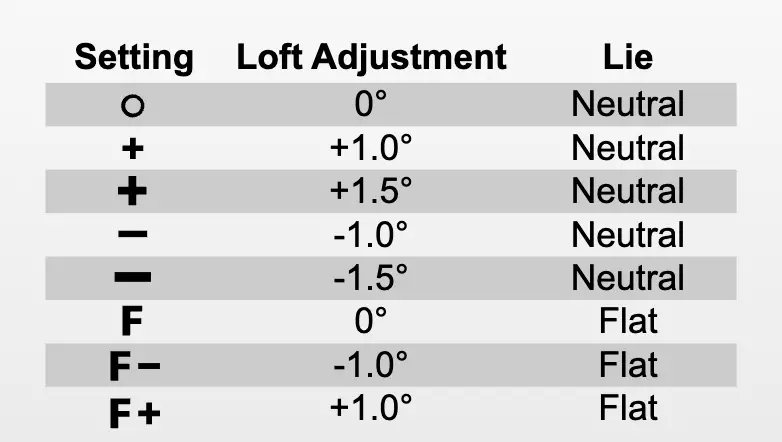
Is the Ping G425 Max a good driver for seniors?
The G425 Max is a great driver for seniors in my opinion because it gives you a little more spin once your swingspeed starts to decrease. The added spin helps the ball get high enough in the air for the optimal trajectory. Here’s some other reviews of the best senior golf drivers.





Lofts Available: 9º, 10.5º, and 12º
Shaft Options: Yes
Pros:
- Very stable feel on impact
- Clean looks with a matte finish
- Did I mention tungsten? (Lots of it!)
- Tons of forgiveness on off-center hits
- Ease of use for beginners and scratch golfers alike
- Ample tungsten weighting to help get the ball in the air
- Similar price point compared to 2021-2022 competitors
Cons:
- “Exotic” shaft options are an upcharge
- Low launch/spin shaft options are limited
- Turbulators are polarizing (some love them, some hate them)
- The driver is louder than its siblings, but not the loudest I’ve hit













Where should the back weight be if you hit the ball straight at a 10.5 loft
Honestly, if you’re hitting it straight, then I personally wouldn’t change it.
But it also depends on your goals. If you want more draw or fade bias, then move the weight accordingly. But keep in mind it’s a BIAS, it’s not going to cure slices and hooks.
If your goal is to get more distance, you could try lowering the loft setting on the hosel, just realize that that is going to slightly open up the face and could promote more of a fade. But also, it does depend on your current trajectory – if you’re hitting it too low already, then I would actually suggest adding some loft to get a little more distance. Again, keep in mind that’s going to close the face a tad and promote a draw.
I hope that helps! Maybe if you post your exact goals on what you’re trying to accomplish, then I can be more specific.